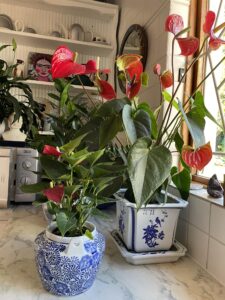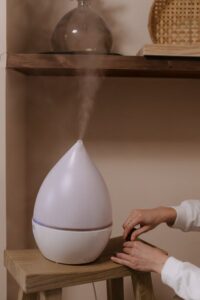Anthurium is a beautiful plant flaunting its pretty-looking flowers in different colors. Usually, they are in a pinkish-red glowing shade.
The plants’ heart-shaped green leaves intensify their beauty. Isn’t it depressing when you lose flowers of those enchanting Anthuriums?
Anthurium blooms are also commonly known as flamingo flowers.
In the initial days of bringing an Anthurium to my home, it was all about admiring it. However, as the days passed, my concern developed when the flowers died.
After some time, I realized that Anthuriums are great care seeker plants. They are prone to wilting, losing flowers, or discoloring if not given attention.

Your heart might be dancing when you see your Anthuriums looking perfectly vigorous. Yet, it is frustrating if they are not flowering despite their sturdy, healthy leaves.
It is not a good sight to see missing gorgeous flowers in many green Anthurium leaves.
As this article covers the losing flowers of Anthurium, we will be discussing how to take care of them and the possible solutions for their causes.
Keep reading to learn more about the Anthurium losing causes of the flowers.
Table of Contents Show
Is it Normal for Anthurium To Lose Flowers?
The normality issue of Anthurium losing flowers is normal and abnormal, depending on the causes.
While you are concerned about your Anthuriums not flowering, they might be undergoing health issues or just a natural lifecycle.
It is usual for Anthurium to lose flowers. The process of getting born, living and dying is the way of nature’s cycle.
A similar phenomenon applies to the flowers of your Anthurium. They grow, die, and are again reborn.
Anthuriums blossom the whole year round. Nevertheless, they prefer the spring and summertime of the year more. It is because, usually, fewer flowers are grown during winter due to less lighting.
However, the flowers last about 2-3 months after they start budding. After that, their color fades away and starts to wither.
Yet, do not be at peace knowing that losing flowers is a natural method.
In hindsight, Anthurium flowers can last long throughout the year if properly cared for.
Do not panic if there is something wrong. Instead, continue reading to figure out probable reasons and their solutions.
Flamingo Flowers Turning Green
Do not worry if your flamingo flowers are turning green in color. It is a sign of aging.

Initially, you will see streaks of green, and later the whole flower becomes green. It is perfectly normal as a natural lifecycle.
Some flowers can turn green prematurely due to an unnatural push in their growth through greenhouse effects by cultivars.
Common Reasons of Anthurium Losing Flowers
Anthuriums are often grown for their colorful flowers that compliments any interior decor.
But with frequent care mishaps Anthurium is bound to lose the flowers.
| Reasons | Prevention | Solution |
|---|---|---|
| Overwatering the Plant | Water once a week in summer and once in two weeks in winter. | Check 1 - 2 inches of topsoil to dry completely before re-watering. |
| Underwatering | Water your plant with 1/2 a cup every week. | Rehydrate by thoroughly soaking the root balls in water by digging them out. |
| Insufficient Light | Provide bright indirect sunlight. | Expose to natural sunlight or even artificial lighting. |
| Temperature Issue | Ideal temperature: 70 - 85 degrees Fahrenheit. | Avoid extreme heat or cold. |
| Low Humidity | Keep the humidity level above 50%. | Use mist sprays, pebble trays, and humidifiers. |
| Wrong Potting Mix | Mix of equal partition of pine bark, perlite, and peat moss. | Take tests to measure the quality of the potting mix. |
1. Overwatering the Plant
Too much of anything is not good. Similar goes for your plants while watering.
Overwatering causes the most common problem – Root Rot. It leads to the death of the plant. Look out for wilting leaves and flowers!
The leaf color can turn yellow but not brown and feels very mushy.
It means that some extra care needs to be given to your Anthuriums.
Prevention
During summer, watering your Anthuriums once a week is good. At the same time, watering them once in two weeks is ideal in the winter.
So, always go for a pot with good drainage system. The pot holes help from overwatering the plants by draining excess water from the pot.
Solution
The frequency of watering your plant might vary with different seasons of the year. For example, summers dry the soil faster, whereas winter keeps the soil moist for a long time.
Sometimes you might be pooling the plant on top of moist soil.
Be wary of checking 1 – 2 inches of topsoil to dry entirely before re-watering them. You can check it with a wooden stick or even with your finger.
2. Underwatering the Plant
Underwatering dries out the soil resulting in compact, brittle soil. In addition, it causes blockage of nutrients and clogs in the plant’s roots.
Therefore, you will experience patchy brown leaves of your Anthurium due to a lack of water supply.
Prevention
Many articles do suggest adding ice cubes to the Anthurium soil. However, I do not think it is a good idea. The coldness of ice can sometimes give the shock the plants.
As a low-risk taker, I recommend weekly watering your plant with 1/2 a cup. Yet, if you still want to try out ice cubes, place six cubes every on the plant’s soil.
Try keeping the soil of your Anthuriums well-hydrated and moist, especially from March to September.
Solution
If your plant is completely dried out, it may show the symptoms of curly brown leaves. Rehydrating is a way out by thoroughly soaking your rootballs in water by digging them out.
3. Insufficient Light
In the beginning days of getting an Anthurium home, I didn’t realize the good amount of lighting the plant required. But, unlike other indoor plants, they are light-hungry plants.
Anthuriums have a high demand for abundant lighting. Therefore, 9 hours a day of good lighting exposure allows your flowers to bloom vibrantly.
Generally, direct sunlight is not preferred by Anthuriums. However, indirect light is the best way out to provide enough energy for them to bloom.
Whereas direct light or the impact of the scorching sun only makes them dehydrated.
Prevention
Dark or low-light rooms do not encourage flowering. However, your Anthuriums can absorb bright indirect sunlight through the following.
- Placing the plant near a window
- Receiving the sun’s reflection through mirrors
- Refracted sunlight from nearby objects
Be wary of the hints of the plant through its leaf color. For example, dark green leaves indicate a lack of sunlight.
Solution
If you discover that your Anthurium is not receiving enough, hurry up and place them in bright indirect light.
Natural lighting
- South-facing rooms or west-facing windows are the ideal options to shift your plant.
- East-facing windows are also not a problem since the sun hits in the early morning with good wind rushes.
- Window with curtains: you can opt for a place near the window with translucent curtains, which lowers the intensity of direct sun.
- Window without curtains: it is better to keep your plant further away, around 4 – 6 feet from the window.
Artificial lighting
The most favorable lighting other than the natural one is LED lights. They are readily available and cheap too. Before directing them on your plants, experiment to find an idyllic area.
Begin with six hours of LED light for adjustments and progressively increase it to 9 hours daily. You can alter the closeness of LED lights depending on the heat it eliminates.
During winter, 16 hours of light exposure would be better due to fewer hours of sunlight.
Whereas in summer, if you expose your plant to indirect sunlight for a few hours, an additional six hours of lighting would be great to boost flowering.
4. Temperature Issue
Anthuriums are fond of warm environments. However, they find it challenging to grow in coldness.
Even the temperature of the water is recommended to be lukewarm and not cold.
Water temperature is to be considered too apart from the surrounding. It is because it will directly impact the leaves and flowers of the plant, making them brown or curled up.
Prevention
Things can get worse due to a lack of awareness. Therefore, it is essential to know what temperature your plants prefer.
During the daytime, 70 – 85 degrees Fahrenheit is ideal for them. Whereas below 60 degrees Fahrenheit should be strictly avoided at nighttime.
Extreme heat or cold can end the life of your plants.
Solution
If the temperature severely impacts your Anthurium, changing the location and adjusting to an ideal temperature is better. Saying this, use a natural method for the adjustment.
Central heating is not an issue for your plant. But never go for air conditioners, near draft areas, ceiling fans, or heat fans, which can adversely affect your plants.
5. Low Humidity
Humidity in the air keeps your plants well-hydrated. But unfortunately, the moisture does not allow dryness.
Prevention
The kitchen or bathroom is the best place to keep your Anthuriums for good humidity and heat.
Try to keep the humidity level above 50%. If this continues, your Anthurium flowers can wither quickly or struggle growing new ones.
Caution Tip: Excess levels of humidity can lead to a negative effect of rotting the plant. Therefore, subtle air flows give a good combination with optimum humidity. But, again, strong air gushes can also dry your plant, leaving them with brown leaves.
A ventilated room is an excellent place to keep your Anthuriums.
Solution
Your Anthuriums’ leaves and flowers might get droopy due to environmental dehydration. It can especially happen in the winter.
Keep misting them with mist sprays. Also, there are pebble trays and humidifiers to rescue the problem. They are readily available in the market and online stores too.

The pebble tray is just a stray with a pebble and water. Its use is that the water does not come in contact with the pot. The evaporated water humidifies the soil and plant.
6. Wrong Potting Mix
Potting mix is also known as potting soil. The right potting mixture helps to bloom your flowers better.
The well-draining mixture avoids the mess of waterlogs. These waterlog stop the airflow carrying oxygen to the plant and even prevent root rotting.
Ultimately, it drowns the plant and makes them dead.
Prevention
A crucial precaution is to have a drainage hole in your pot.
You can even use the potting mix used for orchids.
Your mix can contain various options: perlite, peat moss, fir bark, charcoal, redwood bark, lava rock, coconut fiber, and osmunda fiber.
You can create your mix by playing around with these components. This mix encourages good air circulation in the soil.
However, the highest recommended one is the equal partition of pine bark, perlite, and peat moss. You can add lava rock and redwood bark to one part.
Adding charcoal, broken small bricks, and river sands would be suitable if your Anthuriums are already a year older.
Solution
If you are having a problem with your potting mix, you can apply the following tests to measure the quality of the potting mix.
- Is the mixture good at absorbing the water?
- Does the potting mix well to retain the moisture?
- Is the mixture well-fledged with the required nutrients?
- Does the mixture contain the required pH level (alkaline or acid)?
- Can the mixture harm plants in any form?
- Does the potting mix facilitate well-draining?
Answering the above questions as ‘yes’ indicates a good potting mix.
Whereas answering ‘no’ means you lack ideal care and you might be losing your Anthurium flowers.
7. Natural Process
Nature creates a cycle of birth, life, and death. Likewise, the plants are living too, which go through this process.
So it is natural how the plant bears pretty bright flowers and rich green leaves. But eventually, they will turn brown and wilt with age.
You do not need to worry at all about this matter.
Take good care of your plants and be patient to grow other flowers back again.
Do Anthurium Flowers Grow Back after They Lose Flowers?
You might be sad losing beautiful-looking flowers from your Anthurium. But are they going to bloom back again? Certainly yes.
It is good news that you will be receiving fresh new flowers after the death of the previous ones. But unfortunately, after the flowers’ lifespan of 2 – 3 months, it takes a few more months to grow new ones.
Nevertheless, it takes quite a few years for Anthurium to bloom.
Inducing Hormones for More Flowers
In today’s era, injecting artificial inducement has become quite common in the products we purchase.
For example, the food and the plants we buy are inoculated to make them look appealing.

For commercial purposes, people tend to grow more flowers to look attractive to customers.
Therefore, these growers induce hormones called gibberellic acid to get it. It accelerates the growth numbers and faster growth of blooms. Otherwise, it could even take years.
Growing back flowers of Anthurium is not that difficult. However, continuous upkeep is required to get those red charms.
Why is Your Flamingo Flowers Small?
Any unsuitable environment can trigger the growth of your flowers, making them shrink in size. Too much sunlight exposure is one of the most significant reasons for your flowers turning small.
Apart from the lighting issue, overwatering, unacceptable humidity levels or lack of fertilization are possible reasons.
Tips to Make Anthurium Flower Again
You might be losing your Anthurium flowers due to various reasons. However, it is possible to make them grow again.
Let’s look into some ways to get back your pretty blooms.
1. Remove Dead Blooms or Leaves
Your plants might be holding dead flowers or leaves; the plant will keep sending them the nutrients too.
However, having them on the plants hinders the growth of other new blooms.
Therefore, it is more waste to unwanted parts, which can be devoted more to the healthy parts of the plant.
Therefore if you see any flowers wilting and are dead, it is highly recommended to eliminate them.
Trim them off with clean shears, blades, or scissors. Pruning your plants once in a while keeps them healthy.
However, while cutting off the stem area, watch out for the sap, which can cause skin irritation.
While removing these dead leaves and flowers, cut the leaves close to the plant’s central stem with a sterilized shear. It will help to regenerate a healthy one better.
2. Supply Nutrition to Your Flamingo Plants
Do not hesitate to provide nutrition to your plants. However, be mindful of the brown leaves signaling on lack of potassium, phosphorus, and nitrogen.

You can use slow-release fertilizers with a ratio of 3:2:1 or even phosphorus-rich liquid fertilizers.
But if you are experiencing brown leaves on your Anthurium, apply liquid fertilizers for a few weeks. Then, try it until your plants get better.
Liquid fertilizers rich in phosphorus also help in blooming the flowers, so use them once every week.
The haphazard implication of improper fertilizers to your Anthurium can also lead to losing your plant flowers. Therefore the recommended one is as mentioned above.
3. Use Clean Tools
Always ensure to clean the tools like blades or shears thoroughly using disinfectants before and after pruning the plant.
There could be chances of spreading diseases from one plant to another due to negligence.
Thus you can use disinfectants to clean the tools, such as isopropyl alcohol.
4. Repotting the Plant
Repotting gives the freshness of soil to the plant, revitalizes root knots, and fixes any sizing issues.
Many of us tend to neglect the size of a container when we are planting. Instead, we choose the pot as we please to look aesthetically pleasing.
Too small pots can densely pack the plant’s roots, blocking the proper water and nutrition absorption.
Whereas too big pot can slow down Anthurium flowering. Much energy is wasted to fill up the container’s space rather than on flowers.
The best interval to repot Anthurium is in every 2 – 3 years.
While repotting, remember to have your container 1/3 full of soil.
How to Know When to Repot?
The need for repotting can be figured out when your plant grows bushier and taller. For example, in a pot with 5 inches diameter, 20 inches tall plant is not suitable.
So be ready to change the pot to one size larger (around two inches or 20% larger than the current size) than the previous one, but not a very big one.
5. Check Out for Pests
Anthuriums are usually not prone to pest infestation easily. Nevertheless, have an eye on your Anthurium for any potential invasion.
The possible common ones are mealybugs and scales. They are the sapsuckers of the plant. If they get into the plants, then there is a possibility of losing your blooms too.
If you locate pests on your plants, then take action as mentioned below.
For Scales
- Use Neem oil.
- Spray it with soapy water.
- Clean up with a damp cloth.
- Rub on alcohol.
For Mealybugs
- Spray with insecticidal soap or soapy water.
Final Thoughts
They are not complex plants, and flamingo flowers are irresistible ones not to want them. The right way to take care of Anthuriums is easy with a few tips from an expert. Yet, a bit of effort is required for its flowers to bloom.
Many have the plant in their homes but struggle to gain blooms.
I hope this article comes in use to help beautify your room with vibrant colors of Anthurium flowers.


